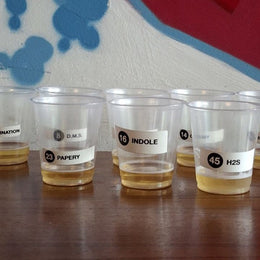
Mead, often referred to as "honey wine," is an ancient beverage that has been enjoyed by civilizations throughout history. In fact, it's said to be the oldest alcoholic beverage recorded.
In recent years, it has experienced a resurgence in popularity among enthusiasts and newcomers alike. If you're curious about this delightful elixir, let's embark on a journey to discover what mead is, how it's made, the various types, and some popular choices to start your mead-tasting adventure.
What is Mead?
Mead is a fermented beverage made primarily from honey, water, and yeast. It's one of the oldest alcoholic drinks known to humanity, with roots dating back thousands of years. It predates even beer and wine! The simplicity of its ingredients gives mead a unique and diverse flavor profile, ranging from sweet and floral to dry and complex. Mead holds a special place in Viking culture. It was a common beverage in Norse society, and the term "honeymoon" is said to originate from the medieval tradition of newlyweds drinking mead for a month (moon) to ensure fertility and happiness.
While mead experienced a decline in popularity for many centuries, there has been a recent resurgence of interest in mead-making. Craft meaderies are popping up, bringing a touch of contemporary flair to this ancient libation that is capturing new tastesbuds.
Inspired by the craft beer revolution and the immense popularity of India Pale Ales (IPAs), mead makers have begun incorporating New World hops into their creations. Much like the bold and aromatic hops that define IPAs, these additions contribute a dynamic layer of flavors and aromas to mead, expanding the traditional boundaries of this historic beverage. An excellent example of this trend is Gosnells, a meadery that has ventured into the world of hops, introducing a Citra-hopped mead. By employing hops like Citra, known for its citrusy and tropical notes, mead makers are crafting innovative blends that appeal to those with a penchant for both mead and the hop-forward profiles that have made IPAs so popular in the craft beer scene.


How is Mead Made?
The basic process of making mead involves mixing honey with water to create a must (unfermented mead), adding yeast to initiate fermentation, and allowing the mixture to ferment until the desired level of alcohol is reached. Mead-making can be as straightforward or as complex as you want it to be, with variations in ingredients, fermentation time, and additional flavorings.
Types of Mead:
Mead comes in a wide range of flavors, from sweet to dry, and can have complex profiles similar to wine. The addition of different fruits, spices, and herbs allows for a diverse array of mead varieties.
- Traditional Mead: Made with just honey, water, and yeast, allowing the natural flavors of honey to shine.
- Melomel: Includes the addition of fruits, such as berries, apples, or citrus, enhancing both sweetness and acidity.
- Cyser: A type of mead where honey is fermented with apple juice or cider.
- Pyment: A blend of mead and grape juice, combining the characteristics of both honey and grapes.
- Metheglin: Infused with spices, herbs, or botanicals, creating a more complex and aromatic beverage.
Meads to Try:
Chaucer's Mead

A classic and widely available traditional mead with a slightly sweet and floral profile. This mead is made in California from three types of honey - orange blossom, alfalfa and sage honey, each bringing unique characteristics to the sweet mead flavour.
Dansk Mjod Viking Blod Mead

Dansk Mjod meads are brewed based on a recipe from about year 1700, and the ingredients are pure and 100% natural. Dansk Mjod combines the traditional brew of honey, hops, brewer's yeast and water with dried hibiscus, which adds an aromatic and floral aftertaste to this mead, like a good madeira.
Redstone Meadery Sunshine Nectar

A delicious melomel with the addition of apricot puree for a dryer, tart, more traditional tasting mead. This mead uses 5 parts Clover Honey and 1 part Wildflow, and even bagged the Gold Medal in the Hydromel category (less than 10% alcohol) at the 2003 International Mead Festival.
Gosnells of London Hibiscus Mead

A tasty pink mead made with European Blossom Honey jam-packed with a truckload of dried Hibiscus flowers. The hibiscus gives this mead a tart jammy, fruit flavour before leading to a dry, almost cranberry-like finish.
Lion City Meadery Longan and Red Dates Mead

Dried longans and red dates that were specially rated for aroma and sweetness are added into this brew. What results is a slightly hazy blonde mead with a strong notes of red dates on the nose, balanced by the warm sweetness and a slight acidity from the dried longans and the honey.
Whether you prefer the simplicity of traditional mead or the complexity of melomels and metheglins, there's a mead out there for everyone. So, pour yourself a glass, raise it to the gods of old, and savour the taste of this timeless nectar.
Cheers!

@lotusroot518







